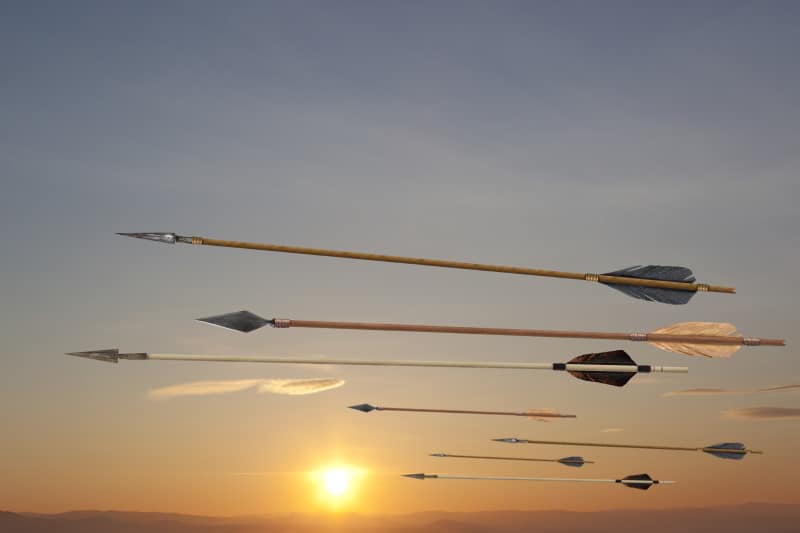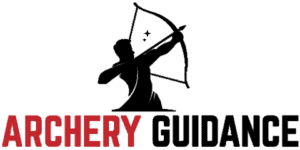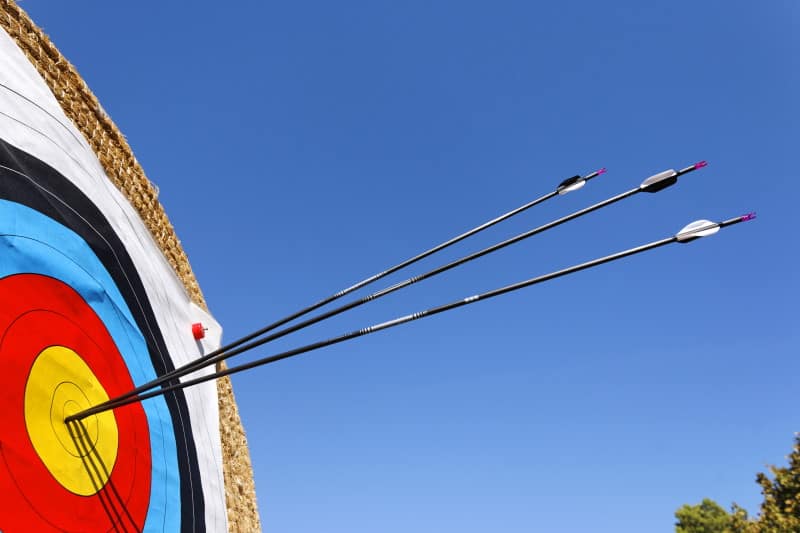When you are purchasing arrows, there are all sorts of components you will need to consider. Is it better to purchase wood arrows or metal ones? Which type of fletching is the best for accuracy? How thick should the arrow’s spine be?
Of these considerations, length seems pretty straightforward. The longer an arrow is, the further it can push into a target… right?
Actually, longer arrows do a lot more than simply bury deeper into their targets. Longer arrows may, in fact, greatly reduce the accuracy of your shot and cause your arrow to spin or veer off target more easily. In fact, a shorter arrow will always fly better than a longer arrow, though this comes with its own safety risks.
Just why exactly is it that a longer arrow results in a worse flying arrow? To learn the answer to this question and more, you will have to keep reading!
How Arrow Length Affects Overall Accuracy

In order to understand this phenomenon, you should read our article on the physics of archery, which you can find here. This article goes further in-depth on the concept of spin in archery and how all the parts of the arrow contribute to this. Another useful article for more information relevant to this discussion can be found here (Can an Arrow Be Too Stiff?), in which we discussed how the thickness of an arrow affects accuracy.
Length is another important component of the arrow that will determine how it flies. However, it does not function alone. The length of the arrow interacts with the thickness of the shaft, the weight of the shaft/point, and the fletching attached to it. This makes it a bit harder to simply say that “If you have an issue with shooting, check the length of your arrow.” When facing a problem with accuracy, look at all of these components.
But let’s set all the rest aside for the time being and focus our attention on length. The first question we need to consider is—can an arrow be too long? Or, to add depth to the discussion, can an arrow also be too short?
An arrow absolutely can be too long or too short. We’ll discuss the safety implications of an arrow that is too short later on in this article, but, for now, let’s leave safety behind and focus purely on accuracy.
A smaller arrow is more accurate, this is a fact. But why? This is due to the way that the arrow interacts with the air that it is passing through. As the arrow leaves the bowstring, it starts to wobble, which is unavoidable. The only way to prevent your arrow from wobbling is to not shoot it, which just isn’t an option.
As the arrow wobbles, it will start to straighten out. How quickly this happens depends on all of the features we mentioned previously, but length is one of the most important aspects. A shorter arrow has less surface area, which results in the arrow straightening out quicker.
The longer your arrow is, the more difficult it will be to straighten out. This results in an arrow that is more likely to go wildly off course or spin out of control. A longer arrow—especially one that is overly heavy—will fly much slower and start to drop much earlier than a properly sized arrow does.
You might think that the way to get around this problem is to use the shortest arrow possible, but it doesn’t work that way. The right length for an arrow needs to be determined by the archer using it. The length of your arm will direct the distance you can draw your bow, which is used to calculate how long your arrow needs to be. We look at this and other safety issues below.
How Do I Measure the Length of My Arrows?

This is as easy as can be. Do you have a tape measure lying around? Good. Grab it and measure your arrow. Start at the bottom from the nock groove and measure until the end of the shaft. You wouldn’t include the point.
What we measure primarily is the shaft of the arrow itself. We consider this to be the arrow and the head, or point, to be a separate piece that is attached. Of course, when you are firing the arrow, we think of the arrow as the entire pack; shaft, point, and fletching combined. But, for the purposes of measuring, we will be focused on the shaft itself.
How Do I Calculate the Length My Arrows Should Be?
There are three ways to calculate this.
The first method is to stretch your arms out in front of you and place your palms together. Stick your fingers out fully, rather than balling them up. Have a friend measure from the middle of your chest through to the very tips of your fingers, then add an inch to the measurement.
The second method to calculate the length at which your arrows should be is to use a draw length indicator, such as this one. This is pretty much an arrow shaft except it has different measurements written all over it. It is also longer than a normal arrow. When you nock it and draw it back, you can find the exact right measurement for the arrows you should be using.
The third and final way of calculating the correct length is to measure your draw. This requires a friend to perform the measurements, since you’ll have your bow in your hands. Draw back the bowstring as if you were going to take a shot, then let your friend measure from the nock point to the front of the riser. Add an inch and a half to this number to get the correct arrow length.
If you learn best through visual demonstration, you can take a look at this video in which a pro archer demonstrates these steps in action:
What Happens If My Arrows Are Too Short?
As you saw above, your arrows are more accurate and fly better the shorter they are. Likewise, if they are too short, then you risk damaging the arrow, your bow, and even yourself.
Damage to your arrow and bow happen for the same reason. If you are using an arrow that is too short, then it won’t extend from your bow when you draw back the string. If you release it without the correct aim, then there is a chance the arrow will strike the bow. This can shatter your arrow, but it could also damage your bow.
As awful as it may be to think about, a bow can always be replaced. The bigger risk is that you may end up firing that arrow straight into (or even through) your own hand. This can result in an injury that ranges from mind to debilitating. You should wear an archery glove (like this) when shooting your bow because doing so can help minimize damage to your hand, but sticking with arrows that are the correct length is the first step you always should take.
For more information about wearing gloves for archery, check out this article.
Outro
An arrow can absolutely be too long. Arrows can also be too short, but being too short doesn’t result in a lack of accuracy, which can lead to a higher risk of injury and potential damage to both the arrow and your bow. The small increase in accuracy that you would get from a too-small arrow is not worth this risk.
Yet, an arrow that is too long is far less accurate than an arrow that is too short. If you absolutely must guess the length you should be using, then going smaller rather than larger is a safe bet. But why guess?
Make sure you measure your draw distance so you can always use arrows that are the correct length. As you saw above, this is extremely easy to calculate. There is no reason for you to have to guess the proper length blindly. By following the easy steps above, you will improve your archery game by a massive degree.
So get out there, measure your draw length, and ensure that you never waste money on arrows that are too long or too short again!

